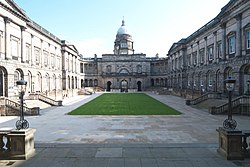 | |
Former name | University of Abertay Dundee |
|---|---|
| Motto | Latin: Beatus homo qui invenit sapientiam |
Motto in English | Blessed is the man who finds wisdom |
| Type | Public |
| Established | 1994 – granted University Status 1888 – Dundee Institute of Technology |
| Chancellor | Alice Brown |
| Principal | Liz Bacon [1] |
| Chair of Court | David Brew |
Academic staff | 208 |
Administrative staff | 300 |
| Students | 4,950 (2022/23) [2] |
| Undergraduates | 4,075 (2022/23) [2] |
| Postgraduates | 875 (2022/23) [2] |
| Location | , Scotland, UK 56°27′48″N2°58′25″W / 56.46333°N 2.97361°W |
| Colours | Blue, Red, Gold and Green |
| Affiliations | MillionPlus [3] GuildHE [4] Universities Scotland [5] |
| Website | abertay |
 | |
 | |
Abertay University (Scottish Gaelic : Oilthigh Obar Thatha [6] ) is a public university in the city of Dundee, Scotland. In 1872, Sir David Baxter, 1st Baronet of Kilmaron, left a bequest for the establishment of a mechanics' institute in Dundee and the Dundee Institute of Technology was formed in 1888. As early as 1902 it was recognised by the Scottish Education Department as an educational hub, and was one of the first to be designated a central institution, akin to an "industrial university". Abertay gained university status in 1994.
Contents
- History
- 1872–1900: The Baxter bequest and Founding
- 1900–1994: Second bequest and First degrees
- 1994–present: University status
- Campus
- Academic profile
- Rankings and reputation
- Research
- Governance
- Notable features
- Computer games education
- Ethical Hacking and Cyber-Security
- Upskilling Short Courses
- Symbols
- Coat of arms
- Motto
- Tartan
- Student life
- Accommodation
- Abertay Students' Association
- Sport
- Notable alumni and staff
- See also
- References
- External links
Abertay launched the world's first computer games degree in 1997 and in 2017 held a programme of events celebrating 20 Years of Games. [7] Abertay was also the first to offer a degree in Ethical Hacking, starting in 2006. [8]



